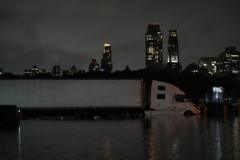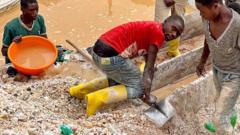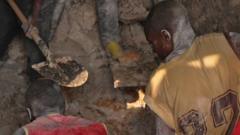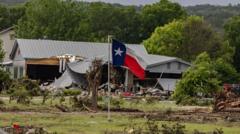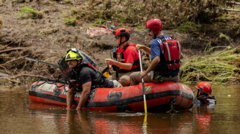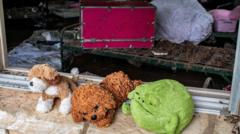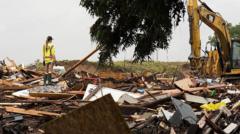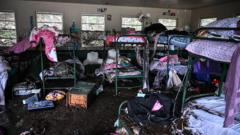At least 33 fatalities have been reported, with residents struggling to cope as the city faces rising waters and inadequate infrastructure amidst ongoing climate challenges.
Tragedy Strikes Kinshasa as Flooding Claims Dozens of Lives

Tragedy Strikes Kinshasa as Flooding Claims Dozens of Lives
Torrential rains in the Democratic Republic of Congo have caused severe flooding, leading to significant loss of life and destruction in Kinshasa.
In a devastating turn of events, Kinshasa, the bustling capital of the Democratic Republic of Congo, has been ravaged by torrential rains resulting in catastrophic flooding that has claimed at least 33 lives, according to local officials. The city's large population of approximately 17 million residents finds itself grappling with the aftermath as floodwaters inundate homes and streets, forcing people to seek refuge by wading, swimming, or using makeshift canoes to escape the deluge.
The Congo River, one of the world's largest, recently reached its highest levels in sixty years, exacerbating the situation in a city known for its low-lying areas prone to soil erosion. The Congolese President has previously warned that climate change is escalating the frequency and severity of flooding in the region.
The areas hardest hit include the outskirts of the capital and impoverished neighborhoods, where reports indicate that floodwaters have risen as high as 1.5 meters. Residents like Christophe Bola from the Ndanu area described the struggle to save themselves while leaving others trapped inside their homes. Frustration has boiled over among the population, with many voicing their anger towards local authorities for their delayed response and insufficient aid.
In addition to the immediate human toll, the floods have severely impacted water supply systems, rendering treatment pumps inoperable, resulting in water shortages across Kinshasa. Key transportation routes, including major roads connecting the city center to the international airport and crucial coastal ports, remain impassable.
The situation is further aggravated by the overflow of the N'djili River, a tributary of the Congo River, which has flooded polluted areas home to many residents, raising public health concerns. Local scientists warn of high levels of fecal matter and waste in these waterways due to poor sewage infrastructure and inadequate urban planning, conditions that the government promised to address last year.
As relief and recovery efforts unfold, heavy rains are projected to continue impacting northern and northeastern regions of the DRC, suggesting that the crisis may worsen before it improves.
The Congo River, one of the world's largest, recently reached its highest levels in sixty years, exacerbating the situation in a city known for its low-lying areas prone to soil erosion. The Congolese President has previously warned that climate change is escalating the frequency and severity of flooding in the region.
The areas hardest hit include the outskirts of the capital and impoverished neighborhoods, where reports indicate that floodwaters have risen as high as 1.5 meters. Residents like Christophe Bola from the Ndanu area described the struggle to save themselves while leaving others trapped inside their homes. Frustration has boiled over among the population, with many voicing their anger towards local authorities for their delayed response and insufficient aid.
In addition to the immediate human toll, the floods have severely impacted water supply systems, rendering treatment pumps inoperable, resulting in water shortages across Kinshasa. Key transportation routes, including major roads connecting the city center to the international airport and crucial coastal ports, remain impassable.
The situation is further aggravated by the overflow of the N'djili River, a tributary of the Congo River, which has flooded polluted areas home to many residents, raising public health concerns. Local scientists warn of high levels of fecal matter and waste in these waterways due to poor sewage infrastructure and inadequate urban planning, conditions that the government promised to address last year.
As relief and recovery efforts unfold, heavy rains are projected to continue impacting northern and northeastern regions of the DRC, suggesting that the crisis may worsen before it improves.


